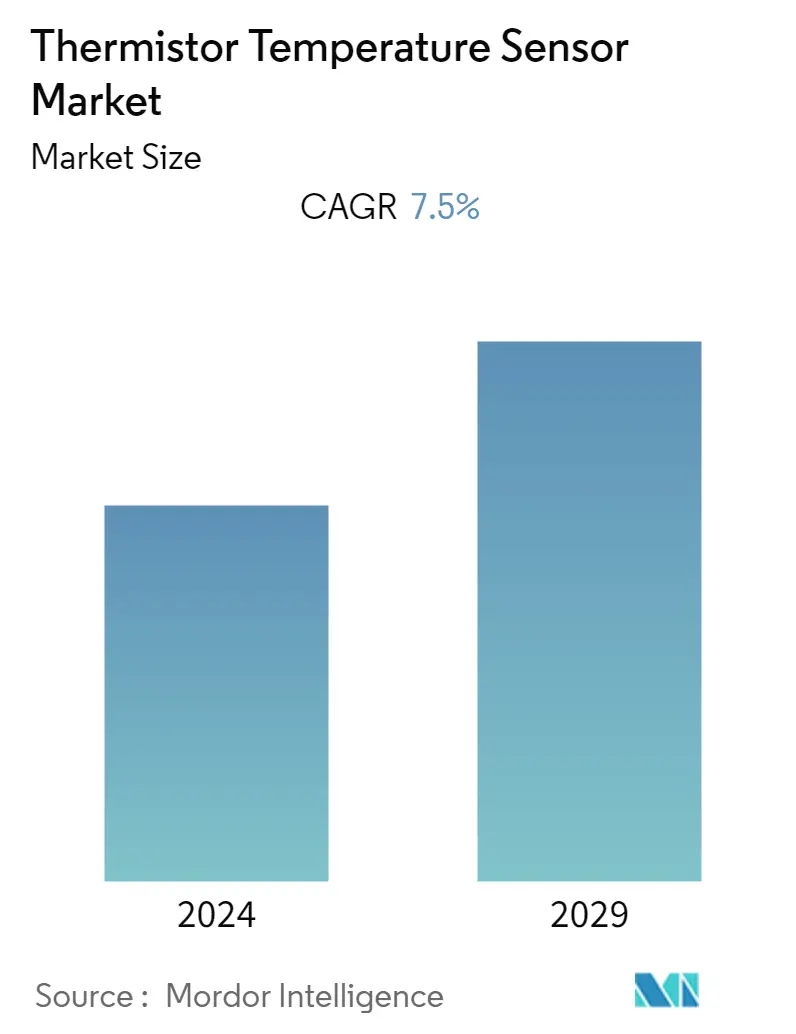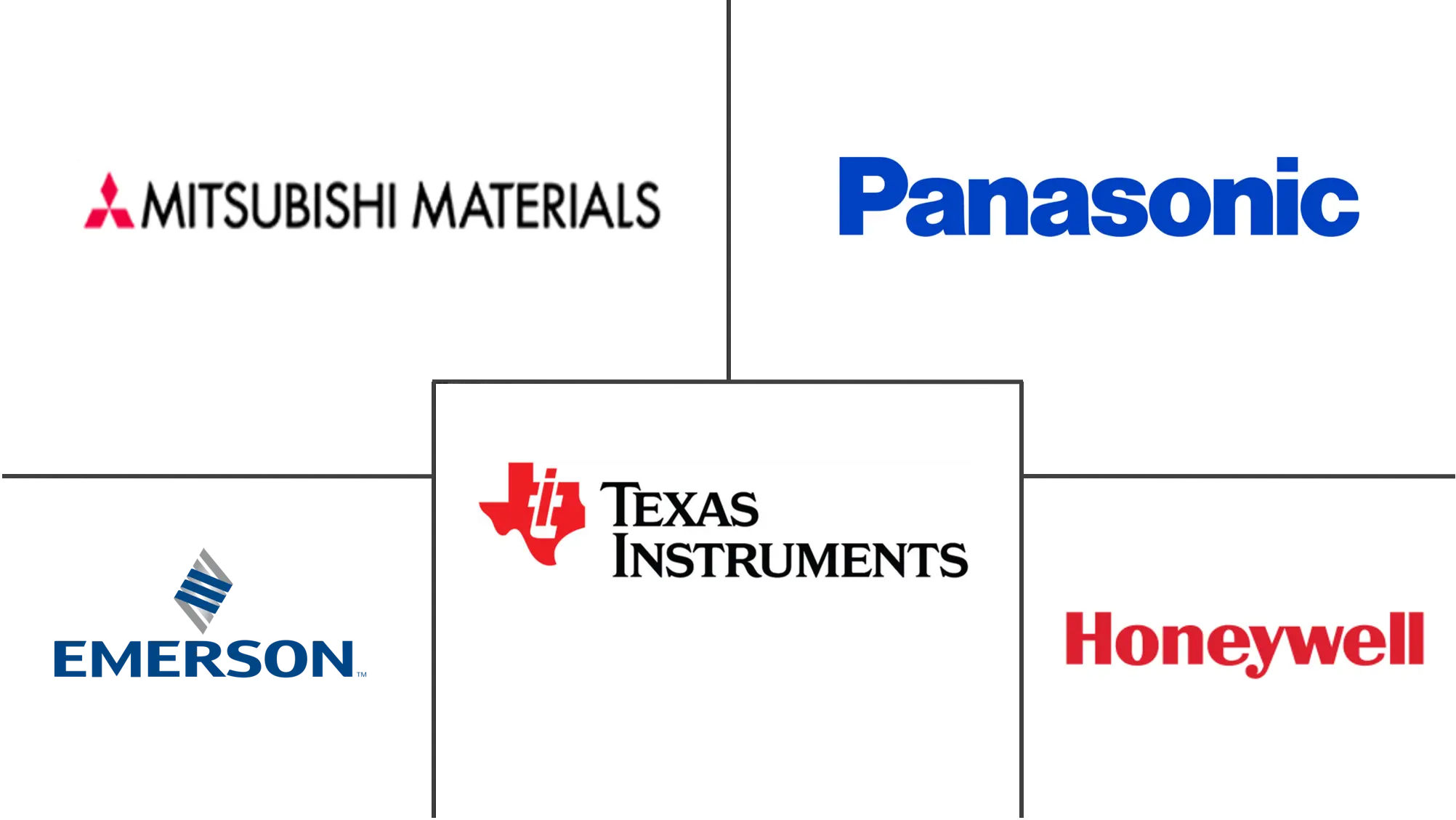Market Size of Thermistor Temperature Sensor Industry

| Study Period | 2019 - 2029 |
| Base Year For Estimation | 2023 |
| CAGR | 7.50 % |
| Fastest Growing Market | Latin America |
| Largest Market | Asia Pacific |
| Market Concentration | Medium |
Major Players
*Disclaimer: Major Players sorted in no particular order |
Thermistor Temperature Sensor Market Analysis
The thermistor temperature sensor market is expected to register a CAGR of 7.5% over the forecast period (2021 - 2026). The growing trend of automation has been identified as one of the important trends in the industry, with the global consumption of sensors growing at a rapid pace across all the verticals. This is expected to influence the demand for thermistors.
- Temperature sensing has become the largest application market for thermistors in recent years, with thermistors becoming the second-most used temperature sensors in various industries. The market for thermistors is dominated by NTC thermistors and functions with high-volume ceramic semiconductor manufacturing, catering substantially to several subsidized end users, like automotive, military, oil and gas, food, and beverages, and healthcare, among others.
- According to Murata manufacturing co. Ltd 'the thermistor market is dominated by NTC type, which has a share of about 70% and PTC has a share of about 30%.'
- Moreover, with the recent advancements in manufacturing techniques, the shortcomings of conventional NTC and PTC thermistors, like aging, interchangeability, and unreliability, are almost eliminated. Further, the booming demand for portable communication appliances is pushing upwards, the demand of NTC thermistors. Also, with several industrial plants adopting smart motors, PTC thermistors are expected to witness demand spikes, as they act as overcurrent protection for different motors.
- The emerging technologies catering to healthcare industries in major economies and the growing applications, like smart patient monitoring systems, are significant factors driving the growth of the thermistor market over the forecast period. The NTC thermistor probes in the healthcare sector are generally used as resistance thermometers.
- Moreover, with the onset of COVID-19, enterprises can neither export their goods nor import raw materials for production because the majority of materials for the production of electronic components are made in China. Also, electronics companies' partners are cutting about 30-50% of orders in several regions.
Thermistor Temperature Sensor Industry Segmentation
A thermistor is a resistor whose resistance is dependent on temperature. Thermistor temperature sensors are mainly used as inrush current limiters. They are also used in temperature sensing devices, self-resetting overcurrent protectors, and self-regulating heating elements.
| Type | |
| Positive Temperature Coefficient (PTC) | |
| Negative Temperature Coefficient (NTC) |
| End-user Application | |
| Chemical and Petrochemical | |
| Power Generation | |
| Metal and Mining | |
| Semiconductor | |
| Automotive | |
| Oil and Gas | |
| Food and Beverage | |
| Life Sciences | |
| Aerospace and Military (includes Aviation) | |
| HVAC | |
| Other End-user Applications |
| Geography | |
| North America | |
| Europe, Middle East & Africa | |
| Asia-Pacific | |
| Latin America |
Thermistor Temperature Sensor Market Size Summary
The thermistor temperature sensor market is experiencing significant growth, driven by the increasing trend of automation and the rapid expansion of sensor consumption across various industries. Thermistors have become a crucial component in temperature sensing applications, particularly in sectors such as automotive, military, oil and gas, food and beverages, and healthcare. The market is predominantly led by NTC thermistors, which are favored for their high-volume ceramic semiconductor manufacturing capabilities. Recent advancements in manufacturing techniques have addressed previous limitations of conventional thermistors, enhancing their reliability and interchangeability. The demand for NTC thermistors is further bolstered by the rising need for portable communication devices, while PTC thermistors are gaining traction in industrial applications, particularly for smart motors.
In the Asia-Pacific region, the demand for thermistors is on the rise due to the evolving automotive landscape and the adoption of electric mobility solutions. The region's dominance in the global HVAC market, coupled with the increasing number of data centers and manufacturing plants, is driving the demand for thermistor-based sensors. The market is highly competitive, with major players like Panasonic Corporation, Texas Instruments Incorporated, and Honeywell International Inc. employing strategies such as product innovation and mergers to maintain their market positions. The ongoing development of connected and autonomous vehicles is also contributing to the market's growth, as vendors continue to introduce solutions tailored to the automotive industry's complex requirements.
Thermistor Temperature Sensor Market Size - Table of Contents
-
1. MARKET DYNAMICS
-
1.1 Market Overview
-
1.2 Market Drivers
-
1.2.1 Demand for Cost Effective and Improved Response Rate Sensors
-
1.2.2 Growing Applications in Consumer Electronics and Connected Devices
-
-
1.3 Market Restraints
-
1.3.1 Unsuitability of Thermistors for Wide Temperature Range and Price Point of Raw Materials
-
-
1.4 Industry Attractiveness - Porter's Five Force Analysis
-
1.4.1 Threat of New Entrants
-
1.4.2 Bargaining Power of Buyers/Consumers
-
1.4.3 Bargaining Power of Suppliers
-
1.4.4 Threat of Substitute Products
-
1.4.5 Intensity of Competitive Rivalry
-
-
1.5 Assessment of Impact of Covid-19 on the Industry
-
-
2. MARKET SEGMENTATION
-
2.1 Type
-
2.1.1 Positive Temperature Coefficient (PTC)
-
2.1.2 Negative Temperature Coefficient (NTC)
-
-
2.2 End-user Application
-
2.2.1 Chemical and Petrochemical
-
2.2.2 Power Generation
-
2.2.3 Metal and Mining
-
2.2.4 Semiconductor
-
2.2.5 Automotive
-
2.2.6 Oil and Gas
-
2.2.7 Food and Beverage
-
2.2.8 Life Sciences
-
2.2.9 Aerospace and Military (includes Aviation)
-
2.2.10 HVAC
-
2.2.11 Other End-user Applications
-
-
2.3 Geography
-
2.3.1 North America
-
2.3.2 Europe, Middle East & Africa
-
2.3.3 Asia-Pacific
-
2.3.4 Latin America
-
-
Thermistor Temperature Sensor Market Size FAQs
What is the current Thermistor Temperature Sensor Market size?
The Thermistor Temperature Sensor Market is projected to register a CAGR of 7.5% during the forecast period (2024-2029)
Who are the key players in Thermistor Temperature Sensor Market?
Mitsubishi Materials Corporation, Honeywell International Inc., Emerson Electric Company, Texas Instruments Incorporated and Panasonic Corporation are the major companies operating in the Thermistor Temperature Sensor Market.

